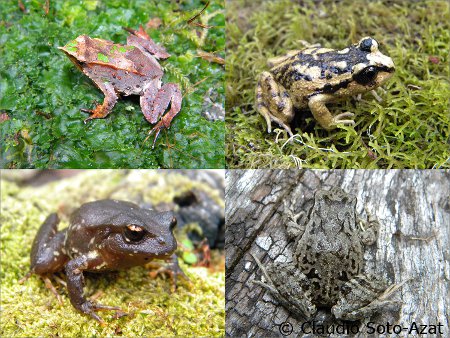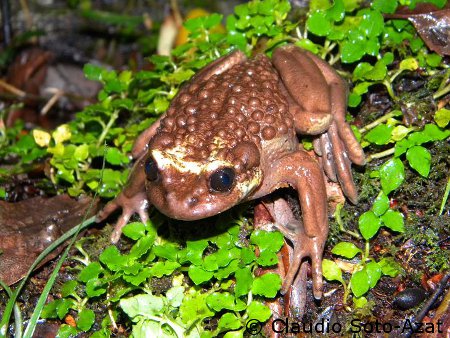
The Nahuelbuta Mountain Range is located within the northern limit of the Valdivian forest ecoregion near the coast of south-central Chile. It is considered a biodiversity hotspot and its fauna and flora is characterized by a high degree of endemism: a lot of species are only found there.
Unfortunately, the forests of Nahuelbuta have been destroyed by the development of agriculture and the forest industry, and today the majority of its surface is covered by pine and eucalyptus plantations.

The only two wild protected areas (Nahuelbuta National Park and Contulmo Natural Monument) have a small area and they are located at high altitudes in the mountains, so the parks will not be able to protect all of the biodiversity in the Valdivian forest.
Nahuelbuta contains 17 amphibian species, including both species of Darwin’s frogs (Rhinoderma darwinii and R. rufum) and five endemic species: the Nahuelbuta spiny- chest frog (Alsodes barrioi), Ramadilla spiny-chest frog (A. vanzolinii), Contulmo ground frog (Eupsophus contulmoensis), Nahuelbuta ground frog (E. nahuelbutensis) and Bullock’s false toad (Telmatobufo bullocki); all of these seriously threatened by extinction. The most critical case is represented by T. bullocki, a species classified as Critically Endangered by the IUCN, and it has rarely been seen since it was officially described in 1952. In addition, Bullock’s false toad is considered one of the most evolutionary distinct amphibians in the world, with an EDGE rank of 5.

Currently, the two wild protected areas in Nahuelbuta do not appear to have any known populations of this frog, but recently a group of Bullock’s false toads of all life stages has been found at the Butamalal river in the Province of Arauco, Bíobio.

Despite this promising news, a Chilean energy company (Hidroeléctrica Butamalal, a subsidiary of RP Global Holding) is planning to develop a mini-hydroelectric power plant in exactly the same area where these frogs exist. Although currently little is known about the biology of the Bullock’s false toad, field observations suggest that adults depend on native forest and tadpoles are adapted to live in fast-flowing waters, so if a dam is built upriver this will be a huge threat to the frogs.
Everything indicates that the company will get the required permits to start its operations, unless the Chilean environmental authorities help to develop adequate plans to protect the local fauna and flora. An environmental declaration made by the hydroelectric company did not include a report on the presence of frogs or an analysis of the possible effects of the project on frogs nearby, despite the area being well known as an amphibian hotspot. This project represents a major threat to the biodiversity of the Butamalal river, and I hope that I can use this information to lobby the government to intervene and stop the project for the sake of the Bullock’s false toad.
Find out more about Claudio and his work with frogs in Chile…